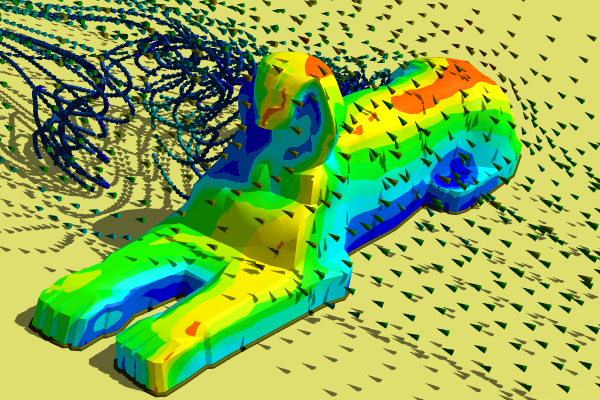
The Great Sphinx CFD Wind Erosion Study
There are many erosion processes that relate directly to either water or air flow. And if it flows, then Computational Fluid Dynamics (CFD) can help. So it should come as no surprise that CFD was used to better understand and predict the wind erosion on the Great Sphinx in Egypt.
 Caedium CFD Simulation Around The Great SphinxRendered in POV-Ray
Caedium CFD Simulation Around The Great SphinxRendered in POV-Ray
The research team of Ashraf S. Hussein (Ain Shams University) and Hisham El-Shishiny (IBM Cairo) performed a detailed CFD analysis of the Giza Plateau in Egypt, which includes the Pyramids and the Great Sphinx. They focused on the Sphinx and demonstrated a good correlation between the actual eroded areas on the Sphinx and the CFD predictions of high shear stress (frictional force) regions under the action of the prevailing winds.
Given that CFD can reasonably predict the eroded regions on the Sphinx, it seems that the next role for CFD could be to help design a deflector to prevent further erosion. Once you get started with CFD it's difficult to stop - it's addictive!
Notes
- Source: Hussein, Ashraf S. & El-Shishiny, Hisham, Influences of wind flow over heritage sites: A case study of the wind environment over the Giza Plateau in Egypt, Environmental Modelling & Software, Volume 24, Issue 3, March 2009, Pages 389–410
- Caedium CFD simulation uses a low resolution SketchUp model of the Great Sphinx of Giza for illustration purposes only and is unrelated to the research mentioned.
Recent blog posts
- CFD Simulates Distant Past
- Background on the Caedium v6.0 Release
- Long-Necked Dinosaurs Succumb To CFD
- CFD Provides Insight Into Mystery Fossils
- Wind Turbine Design According to Insects
- Runners Discover Drafting
- Wind Tunnel and CFD Reveal Best Cycling Tuck
- Active Aerodynamics on the Lamborghini Huracán Performante
- Fluidic Logic
- Stonehenge Vortex Revealed as April Fools' Day Distortion Field

Comments
Take a virtual spin around the Great Sphinx
Caedium CFD Simulation of the Great SphinxStreamlines represented as cones, colored by velocity magnitude
Caedium automatically created each frame in POV-Ray and compiled them into the final video.
Amazing
THAT is one very impressive virtual "spin"!